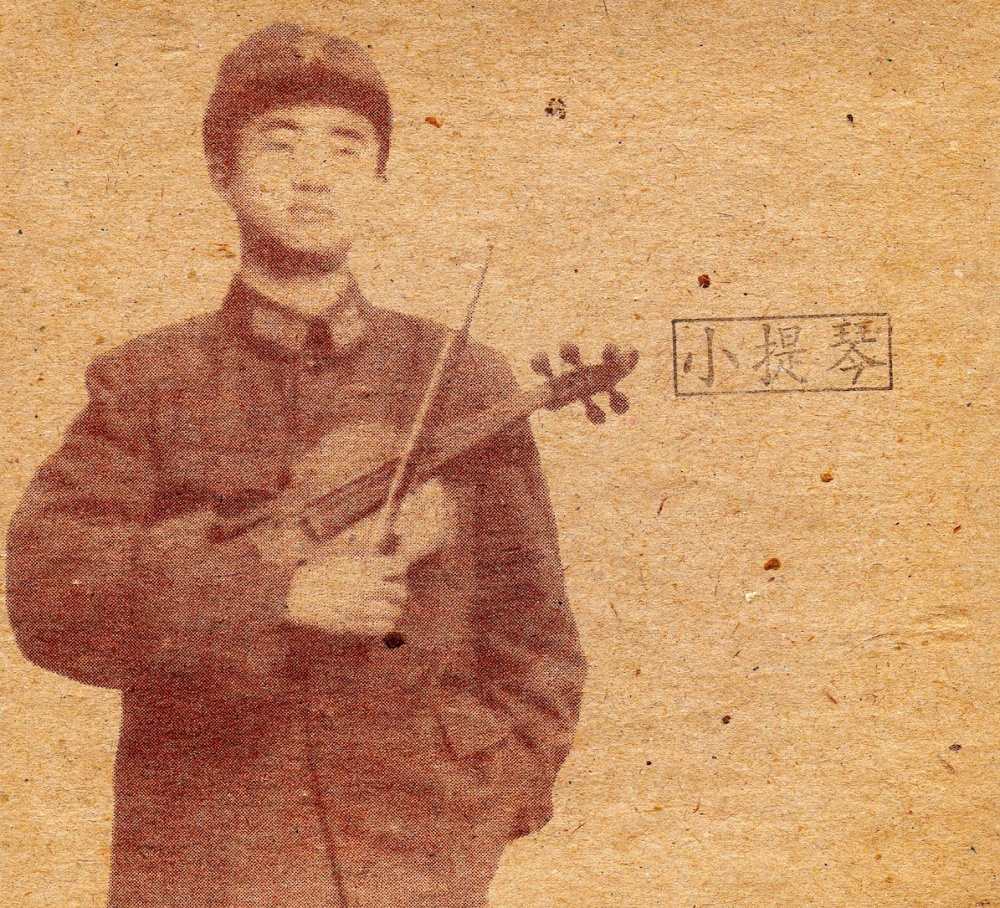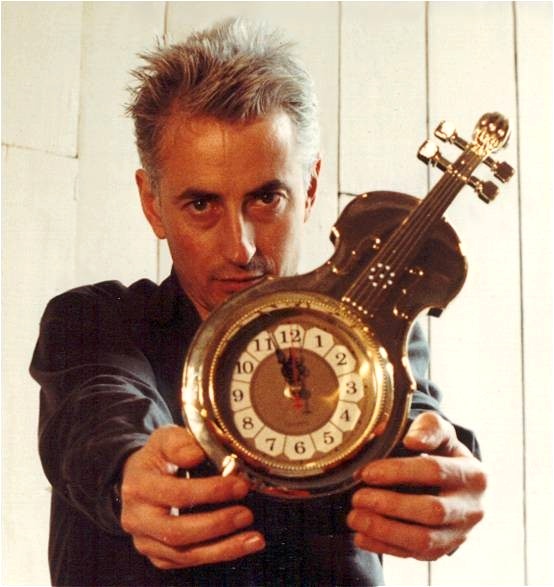Violin Factory
AN INTERACTIVE NEW MEDIA PERFORMANCE PERFORMED in vienna ON 7 DECEMBER 1999
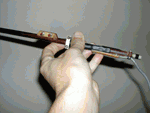 In the 1970s and 80s, as a side line to life as a professional violinist, I was busy constructing violin hybrid instruments, spending a lot of time looking through junk shops in Sydney and elsewhere buying the cheapest violins that little money could buy - violins in really bad condition would often be given to me. I became aware that most of these instruments had been made in China (notably the Skylark, Lark and Parrot models).
In the 1970s and 80s, as a side line to life as a professional violinist, I was busy constructing violin hybrid instruments, spending a lot of time looking through junk shops in Sydney and elsewhere buying the cheapest violins that little money could buy - violins in really bad condition would often be given to me. I became aware that most of these instruments had been made in China (notably the Skylark, Lark and Parrot models).
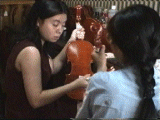 Starting to imagine the factories, full of massed labouring violin makers where these instruments were produced, I balanced my fantasy with the known fact that the average professional western violin player found these instruments to be unplayable and (tone wise) unlistenable to, I took the opposite view. With their shrill tone production, they sounded closer to the er-hu (the traditional chinese two string violin) than to our model of beauty and perfection - the Strad. They were in effect, the sound of Asia, the new string sound of our century!
Starting to imagine the factories, full of massed labouring violin makers where these instruments were produced, I balanced my fantasy with the known fact that the average professional western violin player found these instruments to be unplayable and (tone wise) unlistenable to, I took the opposite view. With their shrill tone production, they sounded closer to the er-hu (the traditional chinese two string violin) than to our model of beauty and perfection - the Strad. They were in effect, the sound of Asia, the new string sound of our century!
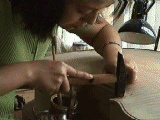 By invitation from The International Jazz Festival Beijing, I've had the opportunity twice in the 1990's to investigate this phenomena further. On the first visit in 1994, full of optimism, I managed to visit a large instrument factory on the outskirts of Beijing. They made just about every instrument under the sun - but tragically no violins. On the second visit last year I took no chances. With help from film maker Ying Li Ma we researched the whole country looking for the violin mass production centres of the world.
By invitation from The International Jazz Festival Beijing, I've had the opportunity twice in the 1990's to investigate this phenomena further. On the first visit in 1994, full of optimism, I managed to visit a large instrument factory on the outskirts of Beijing. They made just about every instrument under the sun - but tragically no violins. On the second visit last year I took no chances. With help from film maker Ying Li Ma we researched the whole country looking for the violin mass production centres of the world.
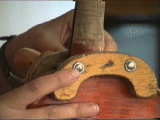 A tale of woe met our enquiries. The two biggest violin factories (employer of thousands) had gone to the wall leaving behind just a few small family firms struggling to maintain the tradition. But, we were told, a brave new world of automation had recently taken over the Chinese violin industry. A visit to a brand new violin factory was arranged. Imagine our excitement as we were told by the manager that they used a specially designed German steam press to stamp out the belly and back plates of violins, violas, cellos, and double basses en masse - ten at a time in one hit! Special machines were available throughout the violin process. They even had a machine that haired and tightened up the violin bow in one go... one bow finished every 5 seconds. In the factory they made absolutely everything that goes into a violin case, including the case itself. At the front of the factory was a pile of wood, at he back of the factory were violins, violas, cellos, double basses - ready to go. Our request to film was emphatically refused.
A tale of woe met our enquiries. The two biggest violin factories (employer of thousands) had gone to the wall leaving behind just a few small family firms struggling to maintain the tradition. But, we were told, a brave new world of automation had recently taken over the Chinese violin industry. A visit to a brand new violin factory was arranged. Imagine our excitement as we were told by the manager that they used a specially designed German steam press to stamp out the belly and back plates of violins, violas, cellos, and double basses en masse - ten at a time in one hit! Special machines were available throughout the violin process. They even had a machine that haired and tightened up the violin bow in one go... one bow finished every 5 seconds. In the factory they made absolutely everything that goes into a violin case, including the case itself. At the front of the factory was a pile of wood, at he back of the factory were violins, violas, cellos, double basses - ready to go. Our request to film was emphatically refused.
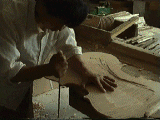 So what video material will actually be shown tonight? Full credit must go to Ying Li Ma. After dealing with months of post rejective depression, she found her way to what remains of the original Chinese violin making factories. In the vast ruined premises of these earlier paradigms of socialist productivity, the camera finds poignant reminders of a by gone age. Where once hundreds of workers sat, labouring away in disciplined harmony to the rousing broadcasts of revolutionary songs, now only a few dozen of the still employed struggle to keep the factory open. We thank their managements for the consideration shown to comrade Ying Li as she filmed the scattered remnants of former production glory.
So what video material will actually be shown tonight? Full credit must go to Ying Li Ma. After dealing with months of post rejective depression, she found her way to what remains of the original Chinese violin making factories. In the vast ruined premises of these earlier paradigms of socialist productivity, the camera finds poignant reminders of a by gone age. Where once hundreds of workers sat, labouring away in disciplined harmony to the rousing broadcasts of revolutionary songs, now only a few dozen of the still employed struggle to keep the factory open. We thank their managements for the consideration shown to comrade Ying Li as she filmed the scattered remnants of former production glory.
 Yes, it's true to say, the new automated violins sound a lot better. (and by 2018, they sound a hell of a lot better and impossibly cheap too at $42 Australian including Post & Packaging. J.R.)
Yes, it's true to say, the new automated violins sound a lot better. (and by 2018, they sound a hell of a lot better and impossibly cheap too at $42 Australian including Post & Packaging. J.R.)
We salute the agony and ecstasy of the former thousands of violin makers in The People's Republic of China, and in the words of Mao Zedong himself!
The masses have a potentially inexhaustible enthusiasm for the violin. Those who can only follow the old tunes in a revolutionary period are utterly incapable of hearing this enthusiasm. They are deaf and all is silence ahead of them. Haven't we come across enough of these kinds of reactionary bureaucrats in music? Those who simply follow the status quo invariably underestimate the people's enthusiasm for the new functional violin music. Let something new appear and they always disapprove and rush to oppose it. Such people are always passively deaf, always fail to move forward at the critical moment and always have to be given a kick in the backside before they move a step.
Introductory note to 'Violin Music went co-operative in two years' (1955) from The Socialist Upsurge in China's Countryside ed. volume 2.
Full PDF details of original performance and internet hook up here












